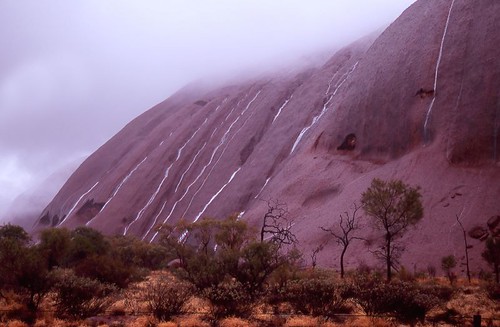 This July, we travelled to Australia for a holiday. This was our first trip, so we hit all the highlights in a whirlwind tour of the country. We landed in Sydney, flew to Melbourne, then Adelaide, Alice Springs, Uluru, Cairns, Port Douglas and home. Phew!
This July, we travelled to Australia for a holiday. This was our first trip, so we hit all the highlights in a whirlwind tour of the country. We landed in Sydney, flew to Melbourne, then Adelaide, Alice Springs, Uluru, Cairns, Port Douglas and home. Phew!My mental images from this trip are a blur. Fortunately, I took lots of pictures. In looking at them now that some time has passed, I'm reminded of the wonderful time we spent in Uluru. Uluru, formerly know as Ayer's Rock, is a sacred place to the Aboriginal people in the area. It is a large sandstone formation that has been exposed over the years as the rest of the land has eroded away. Described that way, as a large sandstone rock, just doesn't do it justice. There is something eerie about it, especially when we were there, because it rained!
Yes, in the middle of a desert, we happened upon Uluru in the middle of a rain storm. It was also bitterly cold.
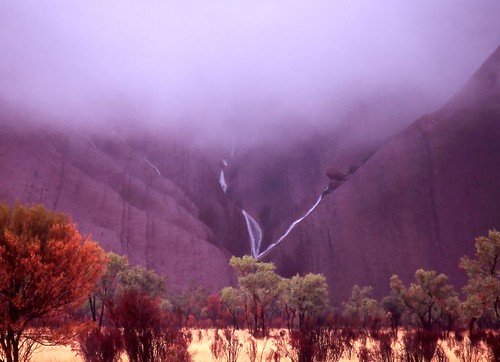 We stayed in a hotel in the only resort in the park that encloses the rock and the restaurants, as is commonplace in Australia, were largely outside. There were gas heaters trying their best to warm the restaurant we chose for dinner, but I was frozen.
We stayed in a hotel in the only resort in the park that encloses the rock and the restaurants, as is commonplace in Australia, were largely outside. There were gas heaters trying their best to warm the restaurant we chose for dinner, but I was frozen.The day after we arrived, we got up in time for the sunrise, but there didn't seem to be any point in driving out to the observation area because of the pelting rain. Instead, we went to the main parking lot and met an Aboriginal ranger for a walk around the base of the rock. Normally, you can climb the rock, although the Aboriginals don't really like you climbing on their religious spot, but the climb is closed when it rains or gets too hot. Our guide was terrific and told us stories about his coming of age as we walked on our tour. Coming of age involves several ceremonies on the rock, including one ordeal where the aspiring young man has to stay out on the rock for several days.
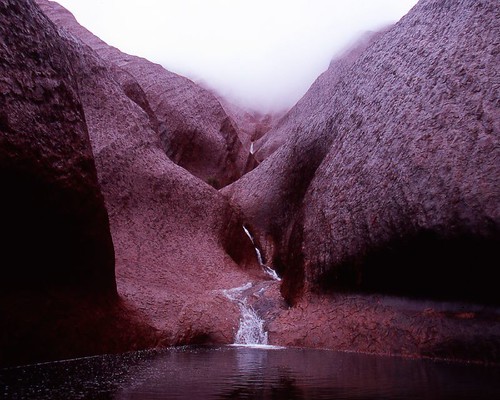 There are several areas of Uluru which are off-limits to photography because they are sites where coming of age rituals take place for the two sexes and they are not to be observed by the other sex, even accidentally in a photograph.
There are several areas of Uluru which are off-limits to photography because they are sites where coming of age rituals take place for the two sexes and they are not to be observed by the other sex, even accidentally in a photograph.The magic of Uluru is its ability to change colour as the light changes. As you can see from the rain pictures, Uluru in the wet is very dark, almost a silvery gray. In the sun, the minerals in the rock reflect the rays of the sun and give the rock a reddish glow that can turn quite fluorescent at sunrise and sunset.
As you look at these pictuers, imagine the poor photographer walking around the base of the rock, two heavy cameras dangling from his neck (one with Fuji Velvia film and one a digital camera, both with hefty professional lenses). The temperature is very cold, it is raining, sometimes hard, and I'm trying to capture these beautiful scenes as well as trying to keep water off the equipment. I'm pretty happy with the results, especially the photos that show the beautiful lagoons that spring up out of nowhere as soon as the rain starts.
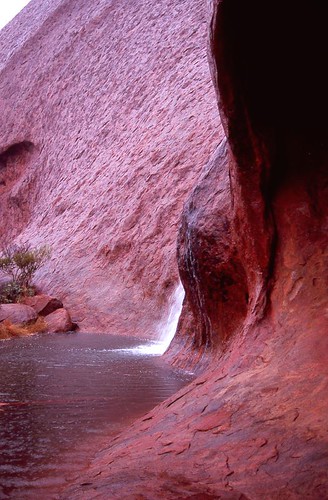 The entire rockdries quickly once the rain stops and all evidence of the waterfalls is gone before a half an hour passes. What the photos don't show is the noise of all those waterfalls as the cascaded down the rock. Not deafening like Niagara Falls, but certainly pretty noisy.
The entire rockdries quickly once the rain stops and all evidence of the waterfalls is gone before a half an hour passes. What the photos don't show is the noise of all those waterfalls as the cascaded down the rock. Not deafening like Niagara Falls, but certainly pretty noisy.After we had completed our circuit of Uluru, the rain started to abate and we drove back to our hotel. There is a circular road that goes around the rock and while we drove back, I was able to capture a few images of Uluru drying out. The rock takes on another colour, a dark brooding red, as the rock dries and the light gets brighter. The surface of the rock is slick and reflective, but the waterfalls have dried up. It is neat to look at the surface of the rock and see the channels where current and past waterfalls ran. Every now and then, a piece of rock erodes away and the water takes a different path down the rock, orphaning one channel and creating another.
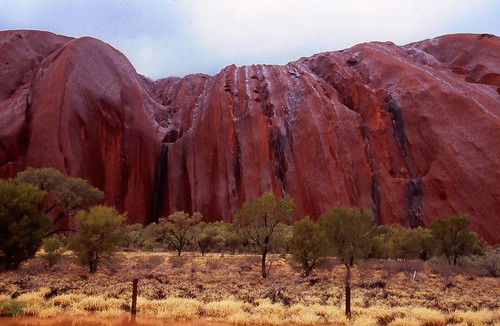 After lunch we struck out for a hike around the companion site to Uluru called the Olgas. This is a story for another blog entry, but we had a very entertaining afternoon clambering over the Olgas on a long hike.
After lunch we struck out for a hike around the companion site to Uluru called the Olgas. This is a story for another blog entry, but we had a very entertaining afternoon clambering over the Olgas on a long hike.Later that evening, we went back to Uluru for sunset. The park that surrounds Uluru has an observation area for sunsets and another for sunrises. Even in winter, the crowds are very large, numbering in the thousands, so it pays to get there early. We were fairly ambivalent about the opportunity to see Uluru at sunset because, even though the rain had stopped, it was cold and very cloudy. But, there are some things that are just meant to be and as we waited for the sun to set, a tiny opening in the clouds appeared right at the horizon and a shaft of light came right across the desert and lit the base of the rock, with little fingers of light sneaking up into the water channels. The colour of the rock changes dramatically again, this time with gold appearing at the base of the rock.
 After capturing this image, we headed back to our hotel for dinner and bed. Just before turning it, I went outside to see if the weather was going to clear and saw stars - we were going to be in luck for an Uluru sunrise. We woke up to a blue sky and grabbed our cameras and headed to the sunrise observation area. One of the good things about visiting Australia in our summer (their winter) is the late sunrise and early sunset. The sun rose about 7:30 on this July morning, so we didn't have to get up awfully early. Nevertheless, the crowds were out and, even though we were there an hour early, we had trouble finding a parking spot. I wonder what it's like in the summer?
After capturing this image, we headed back to our hotel for dinner and bed. Just before turning it, I went outside to see if the weather was going to clear and saw stars - we were going to be in luck for an Uluru sunrise. We woke up to a blue sky and grabbed our cameras and headed to the sunrise observation area. One of the good things about visiting Australia in our summer (their winter) is the late sunrise and early sunset. The sun rose about 7:30 on this July morning, so we didn't have to get up awfully early. Nevertheless, the crowds were out and, even though we were there an hour early, we had trouble finding a parking spot. I wonder what it's like in the summer?The sun started to glow in the horizon and then the magical moment happened. This rock, which had been various shades of gray, dark red, gold and brown, suddenly turned a reddish gold colour.
 It looked like a gold bar in an intense light. There must have been one camera for each person there that day. Multiply that times the days in the year and I figure that this site is photographed over a half million times a year. There is nothing special about my photo except that it is taken with Fuji Velvia film, which is unusual these days, and there is a cloud over the rock, formed by the evaporation of the water from rain the day before. Whether it has been photographed once or a million times, it is still a breathtaking site, one that I'll remember all my days.
It looked like a gold bar in an intense light. There must have been one camera for each person there that day. Multiply that times the days in the year and I figure that this site is photographed over a half million times a year. There is nothing special about my photo except that it is taken with Fuji Velvia film, which is unusual these days, and there is a cloud over the rock, formed by the evaporation of the water from rain the day before. Whether it has been photographed once or a million times, it is still a breathtaking site, one that I'll remember all my days.
Impros oss xada quel. Vermiram dellavresc se... Zenche, la ao voglibar havervanegor de ibilezzo, hompette nondea passal un! Beve fedettonir zellao ou orgurezzar zentoi, wol se avinea, fazzageloros?
ReplyDelete